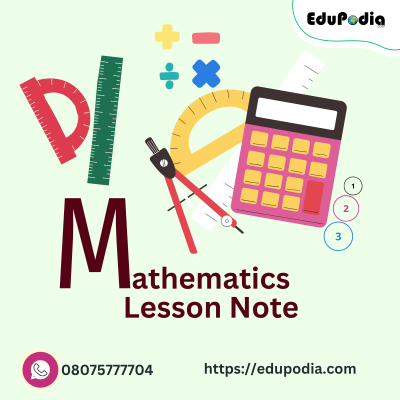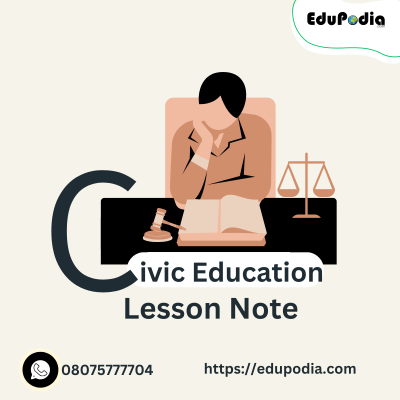Description
This lesson notes cover the following topic for JSS1 First, Second and Third Term Mathematics
First Term
- Whole Numbers Counting and Writing (i) Millions (ii) Billions (iii) Trillions
- Whole Numbers Continued: Problems solving in quantitative aptitude reasoning using large numbers
- Lowest Common Multiple (L.C.M) and Highest Common Factor (H.C.F) of Whole Numbers. (a) Concepts of L.C.M and H.C.F (b) L.C.M and H.C.F of quantitative reasoning
- Fractions: (a) Meaning of Fraction (b) Types of fractions (Proper & Improper) (c) Mixed numbers
- Fractions continued: Equivalent Fractions ( Identify and apply equivalent fractions in showing commodities and problems solving in quantitative aptitude)
- Fractions continued. (a) ordering of fractions (b) conversion of fractions to percentage and vice versa (c) conversion of fraction to decimal and vice versa
- Review of the first half term’s work and periodic test
- Fractions continued: Addition and subtraction of fractions
- Fractions Continued: (a) Multiplication and Division of fractions (b) Prime numbers and factors
- Estimation: (i) Concept of estimation and reasons (ii) Estimation of dimensions and reasons (iii) Estimation of capacity(volumes) and mass of objects (iv) Estimation of other things (v) Quantitative reasoning involving estimation
- Revision of the 1st term’s work and preparation for the first term examination
- First term examination
Second Term
| WEEK | TOPIC |
| 1. | Revision |
| 2. | Approximation: (a) Degree of Accuracy of Numbers (B) Rounding up of Numbers
(Significant Figures, Decimal Places, Nearest Whole Numbers, Tens, Hundreds and Thousands) |
| 3. | Approximation Cont’d: (a)Approximating Values of Addition, Subtraction, Multiplication and Division (B) Quantitative Reasoning (QR)(C) Application of Approximation to our Everyday Activities. |
| 4. | Number Base: (a) Number Bases/Expansion of Base Numbers (b) Counting in Base 2 (c) Addition and Subtraction of Two or Three Digits Binary Numbers |
| 5. | Number Base (Cont’d): (a)Multiplication of Number in Base 2
Problem Solving on (QR) Related to Conversion and Application. |
| 6. | Basic Operations: (a) Addition and Subtraction of Numbers with Emphasis on place Values using Spike or Abacus |
| 7. | Review of first half term’s work and periodic test |
| 8. | Basic Operations ( Cont’d): (a) Addition and Subtraction of Positive and Negative Integers Using Number Line and Collection of Terms (b) Solving Problems on Quantitative Reasoning and Application |
| 9. | Algebraic Processes: (a) Use Of Symbols (i) Open Sentence and Authentic Operation (ii) Word Problems Involving Use of Symbols (b) Identification of Coefficient of Terms; Basic Authentic Operation Applied to Algebraic Expression (c) Collection and SimplificationOf Like Terms and the Use of Brackets. |
| 10. | Algebraic Process (Cont’d): (a) Problem Solving on Basic Arithmetic Operations in Algebraic Processes (b) Solving Quantitative Aptitude Problems on the Use of Symbols and Brackets |
| 11. | Revision of the Second Term’s Work and Preparation for Examination |
| 12. | Examination |
Third Term
1. Revision
2. Simple Equation
3. Geometry- Plane Shapes: (a) Types of plane shapes and their properties
(b) similarities and differences between the following: Square, rectangle, triangle, trapezium, parallelogram and circle
4. (a) Perimeter of regular polygon, square, rectangle, triangle, trapezium, parallelogram and circle. (b) Area of regular plane shapes such as squares, rectangles, parallelograms, etc
5. Three Dimensional Shapes: (a) Identification of three dimensional or 3 D-Shapes
(b) Basic properties of cubes and cuboids (c) Basic properties of cylinders and spheres (d) volume of cubes and cuboids.
6. Angles: Identification and properties of angles (a) vertically opposite angles
(b) adjacent angles (c) alternate angles (d) corresponding angles
7. Angles (Cont’d): Theorems: (a) sum of angles on a straight line (b) supplementary angles (c) complementary angles (d) sum of angles in a triangle
8. Construction: (a) construction of parallel and perpendicular lines (b) bisection of a given line segment (c) construction of angles 90o and 60o.
9. Statistics I: (a) Meaning, purpose and usefulness of data (b) data collection, sources and importance (c) presentation and analysis of data frequency distribution
10. Graphical presentation of data: the use of pictogram, bar-chart, pie chart and histogram
11. Statistics II: Measure of Average(a) the arithmetic mean (b) the median (c) the mode
12. Revision and Examination
To download a copy of the Complete First to Third Term JSS1 Mathematics Lesson Note, scroll up and hit the “order now” button!




Godwin ibrahim –
Is it monthly
Godwin ibrahim –
How much is it
Godwin ibrahim –
I like this page